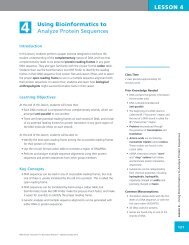WET LAB DNA Barcoding: From Samples to Sequences - Northwest ...
WET LAB DNA Barcoding: From Samples to Sequences - Northwest ...
WET LAB DNA Barcoding: From Samples to Sequences - Northwest ...
Create successful ePaper yourself
Turn your PDF publications into a flip-book with our unique Google optimized e-Paper software.
<strong>WET</strong> <strong>LAB</strong><br />
Wet Lab: Slide #9<br />
14. Show Slide #10, which is a table from an important paper in the <strong>DNA</strong><br />
barcoding scientific community (by Dr. Ivanova and colleagues).<br />
Explain <strong>to</strong> students that this paper was written by genetic researchers who<br />
do <strong>DNA</strong> barcoding. They collected <strong>DNA</strong> sequence data of the barcoding<br />
gene from many different species, performed multiple sequence alignments<br />
<strong>to</strong> compare the sequences, and then created the many different PCR primers<br />
that correspond <strong>to</strong> each of these sequences <strong>to</strong> barcoding new samples or<br />
species. The different PCR primers are mixed <strong>to</strong>gether <strong>to</strong> create primer<br />
pools–collections of PCR primers that can be used with different types of<br />
samples for which the exact sequence of the <strong>DNA</strong> barcoding gene (and thus<br />
the corresponding PCR primers) is not known. Primer Pool COI-2 has been<br />
used successfully for PCR with samples from mammals, fish, and insects. Primer<br />
Pool COI-3 has been used successfully for PCR with samples from amphibians,<br />
reptiles, and mammals. Birds may also be barcoded, but students may wish <strong>to</strong><br />
try both primer pools with bird samples. This process is explained further in the<br />
“<strong>DNA</strong> <strong>Barcoding</strong>” animation found in the Materials section.<br />
15. Tell students <strong>to</strong> note on a sheet of paper or in their lab notebook which<br />
primer pool they will be using in this experiment, based on the type of sample<br />
they are working with.<br />
Deoxyribonucleotide triphosphates<br />
(dNTPs): These are the bases are used<br />
for making <strong>DNA</strong>. They are abbreviated<br />
as dATP (deoxyadenosine triphosphate),<br />
dCTP (deoxycy<strong>to</strong>sine triphosphate), dGTP<br />
(deoxyguanine triphosphate), and dTTP<br />
(deoxythymidine triphosphate). A mixture<br />
containing all four deoxyribonucleotide<br />
triphosphates can also be described as a<br />
“set of dNTPs.”<br />
Primers: Small pieces of <strong>DNA</strong> used <strong>to</strong><br />
start or “prime” <strong>DNA</strong> synthesis, as in<br />
<strong>DNA</strong> replication and PCR.<br />
Buffer: A substance used <strong>to</strong> stabilize or<br />
maintain the pH of a solution.<br />
Primer pools: Collections or mixtures of<br />
primers, usually used in PCR.<br />
Wet Lab: Slide #10<br />
Wet Lab – <strong>DNA</strong> <strong>Barcoding</strong>: <strong>From</strong> <strong>Samples</strong> <strong>to</strong> <strong>Sequences</strong><br />
331<br />
©<strong>Northwest</strong> Association for Biomedical Research—Updated Oc<strong>to</strong>ber 2012
















